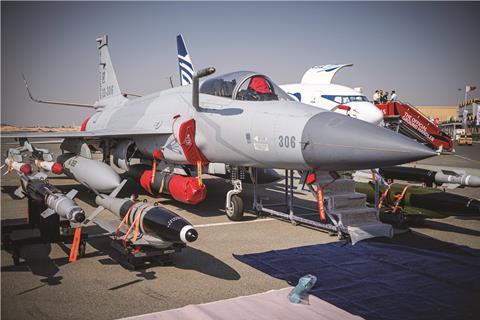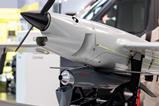The Pakistan air force’s (PAF’s) JF-17 Thunder fighter is making a repeat appearance at the show, with three of the jets in attendance – including one in the Chengdu/Pakistan Aeronautical Complex-developed type’s new Block III standard.
Operated by the service’s 8 Sqn, or “Haiders”, the latest-model example on view in the static display area is visiting from the PAF’s Masroor air base. Reformed earlier this year and now fully operational, it is the second PAF unit to receive the Block III-standard JF-17, after 16 Sqn.

Powered by a Klimov RD-93 engine, the fighter’s newest version boasts a Nanjing Research Institute of Electronics Technology KLJ-7A active electronically scanned array radar, in addition to an increased weapons load.
On display with a broad array of air-to-air and air-to-surface weapons, plus anti-ship missiles, the Block III aircraft has eight hardpoints, including a new twin-store station on its outer under-wing pylon.
The type also features a fixed in-flight refuelling probe and an enhanced self-protection system. The latter includes a new missile approach warning system, and an OESP automatic chaff and flare dispenser mounted atop its tail.
Deployment of the JF-17s to Bahrain was completed with support from a PAF Ilyushin Il-78 tanker, with the journey from Masroor completed in roughly 2h 30min.
The Haiders were among participants in the recent bilateral Indus Shield-Chinese exercise conducted with the People’s Liberation Army Air Force (PLAAF).
Staged from Rafiqui air base, and wrapping up in early November, the activity also involved participation by some of the PAF’s Chinese-built Chengdu J-10C fighters.
PLAAF assets involved in the manoeuvres included J-10 and Shenyang J-16 fighters, along with Shaanxi KJ-500 airborne early warning and control and YTG-9 electronic warfare aircraft. Also supporting the training activity was a deployment by China of the HQ-22 air-defence system.
The PAF says the recent exercise’s objective was “to foster a robust understanding of modern airpower employment dynamics among the participating air forces… validating interoperability, and to further consolidate the existing strategic partnership between the two nations”.
“Indus Shield-Chinese has maximised the warfighting potential of both the participating air forces, alongside fostering mutual understanding and respect,” the service adds.
Pakistan now has 123 JF-17 combat aircraft in service, with another 35 on order, and also employs 25 as dedicated trainers.
“It is the backbone of the PAF. We rely on it,” one of the service’s pilots tells Flight Daily News. “It is war-tested,” he adds. Referring to the recent exercise with the PLAAF, he says: “it helps us to sharpen our tactics and stay up to date”. The services train together on an annual basis.
With the help of its air force, Pakistan is promoting the JF-17 to potential new international operators. While the type has not been acquired by China, it has begun to pick up significant export momentum.
“Equipped with state-of-the-art avionics, enhanced weaponry, and advanced electronic warfare systems, the JF-17 Block III boasts superior manoeuvrability, extended range, and enhanced combat capabilities,” the PAF says.
Myanmar has so far fielded seven JF-17s, with another nine on order, while Nigeria’s air force has received three. Azerbaijan, meanwhile, recently announced an order – brokered by Pakistan – for a dozen JF-17s, including four two-seat trainers.
Baku’s commitment emerged in late September, when president Ilyam Aliyev toured a PAF aircraft at the Azerbaijan Defence Exhibition. “The jets have already been integrated into the arsenal of Azerbaijan’s air force,” the nation’s defence ministry said.
A trio of PAF-operated JF-17s made the type’s debut Bahrain show appearance in 2022, drawn from the Masroor-based 2 Sqn “Minhasians”.































